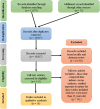Minimum Time Dose in Nature to Positively Impact the Mental Health of College-Aged Students, and How to Measure It: A Scoping Review
- PMID: 31993007
- PMCID: PMC6970969
- DOI: 10.3389/fpsyg.2019.02942
Minimum Time Dose in Nature to Positively Impact the Mental Health of College-Aged Students, and How to Measure It: A Scoping Review
Abstract
Background: Across the U.S., college and university students exhibit high levels of stress, anxiety, depression, and other mental health issues. While counseling, medications and, in more severe cases, hospitalization are all appropriate treatments for such conditions, an increasing body of evidence has demonstrated that spending time in nature can provide tangible benefits for mental health and well-being. The aim of this study was to define a "dose" of time in nature that could be prescribed to college-age students, as a preventative and supportive mental health and well-being intervention. The specific objectives of this scoping review were thus: to define the minimum amount of time in nature that results in positive impact on mental health and well-being for college-aged students; to describe the types of engagement with nature that elicited the impact; and to describe and explore the most commonly used measure of effect pre- and post-time in nature. Methods: This scoping review was conducted following the PRISMA-ScR Checklist. A review protocol was developed but not registered. Fourteen bibliographic databases were searched and all results were blindly screened using established inclusion criteria. All titles and abstracts were screened by at least two reviewers, a third being used as a tie-breaker if needed. Studies were included if: subjects were of average college age; they examined a treatment of time (hours or minutes) in nature; they examined change in measures of mental health and well-being pre- and post-exposure; they compared participants across at least two environments; the study was published in English or French; and if the study was <20 years old. Results: Initially, 11,799 titles were identified and once de-duplicated, 10,917 titles were screened. One hundred fifty-five papers were given full text reviews, of which 14 studies were included in this review. In summary, 13 of the 14 papers explicitly noted that the participants were college students. Two-thirds of the studies (n = 10) took place in Japan. One study took place in Sweden, and the remaining studies took place in the United States (n = 3). These studies show that, when contrasted with equal durations spent in urbanized settings, as little as 10 min of sitting or walking in a diverse array of natural settings significantly and positively impacted defined psychological and physiological markers of mental well-being for college-aged individuals. Within the included studies, 22 different measures were used to assess the effects of nature doses on mental health and well-being. Conclusions: This review provides time-dose and activity-type evidence for programs looking to use time in nature as a preventative measure for stress and mental health strain, and also demonstrates opportunities in six specific foci for more research in this area.
Keywords: college; mental health; nature; stress; time dose; university; well-being.
Copyright © 2020 Meredith, Rakow, Eldermire, Madsen, Shelley and Sachs.
Figures
References
-
- American College Health Association (2017). American College Health Association-National College Health Assessment II: Reference Group Executive Summary. Available online at: https://www.acha.org/documents/ncha/NCHA-II_SPRING_2017_REFERENCE_GROUP_... (accessed August 29, 2019).
-
- American Psychological Association (2019a). Stress Effects on the Body. Available online at: http://www.apa.org/helpcenter/stress-body.aspx (accessed August 23, 2019).
-
- American Psychological Association (2019b). The State-Trait Anxiety Inventory (Stai). Available online at: https://www.apa.org/pi/about/publications/caregivers/practice-settings/a... (accessed August 23, 2019).
-
- Association of University College Counseling Center Directors Annual Survey (2017). Available online at: https://www.aucccd.org/assets/2017%20aucccd%20survey-public-apr17.pdf (accessed September 12, 2019).
Publication types
LinkOut - more resources
Full Text Sources
Miscellaneous



